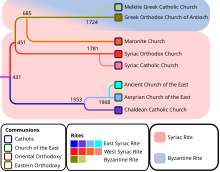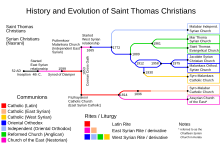St. Mary's Orthodox Cathedral, Arthat
| Arthat St Mary's Orthodox Cathedral | |
|---|---|
 Arthat St Mary's cathedral | |
| Religion | |
| Affiliation | Malankara Orthodox Syrian Church |
| District | Thrissur |
| Province | Kerala |
| Ecclesiastical or organizational status | Cathedral |
| Location | |
| Location | |
| Geographic coordinates | 10°37'58"N - 76°3'29"E |
| Architecture | |
| Type | Church |
| Style | Kerala Architecture |
| Direction of façade | West |
| Website | |
| http://arthatcathedral.org/ | |
Arthat St Mary's Orthodox Cathedral (Arthat Valiyapally) also called Kunnamkulam-Chattukulangara Church[1] is an ancient church located in Arthat village of Thalapilly Taluk, one mile south of Kunnamkulam town, Thrissur, Kerala, India. This church did not participate in the Synod of Diamper. During the invasion of Tippu Sultan the church was arsoned and later reconstructed.[2]
History[]
The local belief states that St Thomas came to a region near present-day Kunnamkulam where Jews were colonized. He preached gospel to the Jews and many were converted to Christianity. The Jewish Synagogue in that area was later converted to a Christian church. This church was known as Chattukulangara pally. When St Thomas came to Judakunnu (Jew hill), there occurred a water scarcity in that area at that time. People were in great distress and they appealed to St Thomas for help. He whipped on the land on the top of the hill and there appeared a spring of fresh water. This was later called Chattakkulam. (ml:ചാട്ടക്കുളം) and the church near to it came to be known as Chattakkulangara pally.
In contradistinction to this twentieth century identification, the traditional site where the establishment of a Christian community in the region is believed to have occurred has been the Palayur Church at least since the fourteenth century.[3][4][5][6]
In 1789 Tippu Sultan attacked and arsoned this church. It is said in folklores that Tippu's army killed a priest in the Altar room of this church and the blood spilled over there. Since it was considered impure, some part of the Altar was cut and removed. Hence this church was also called as Vetti muricha pally (ml:വെട്ടി മുറിച്ച പള്ളി) or cut altar church. Even now the Altar of this church remain distinct from other churches.
Starting from the Coonan cross oath of 1653, both the factions of Malankara Nasranis wanted to take over the church to their fold and because of the dispute the church was closed for a while. In 1805 with the request of the them, the then King of Cochin, Sakthan Thampuran himself came to Arthat church to resolve the problem. Both parties agreed for a lucky draw. In the lucky draw the main church and buildings were gone to the Malankara Puthenkoor Syrians and the Stone cross of the church gone to the Pazhayakoor Syrians.
In 1800 Francis Buchanan visited this church and met Ittoop Malpan,(Pulikkottil Joseph Mar Dionysious I / Mar Dionysius II).
In 1806 the Arthat Padiyola (resolution) declared to break all the chains of Rome, Babel & Antioch.[7]
In 1808 Dr.Claudius Buchanan & Colonel Macauley made a visit and awarded a large gold medal to this principal church in the name of all Syrian churches in Malayalam.[8]
Colonel Macaulay has accompanied me thus far We first proceeded from Cochin to the famous Shanscrit college at Trichur and thence to a district of the Syrian Christians which I had not before visited. It was named by Hyder, Nazarani Ghur or the city of the Nazarenes. It is a beautiful place fertile and populous. The town is four square having four gates built on the side of a hill with steps cut in the rock from street to street surrounded by lofty groves of palm and other trees. A verdant meadow winds about the foot of the hill and the whole country is a scene of hill and dale. The priests and peo pie knew me and received us with great affection. Colonel Macaulay accompanied me to the principal church. Having signified my intention of presenting a large gold medal to this church in the name of all the Syrian churches in Malayalam, a vast concourse of people assembled. There is no person in the town but Nazarenes. The medal which I presented to them was that which Mrs. J gave me before I left Calcutta. It is about three times as large as a college gold medal and exhibits the baptism of Jesus in Jordan elegantly executed and on the reverse a child brought to be baptized. I placed it on the altar in the presence of the people with due solemnity and beside it a gift to the poor. This town is in the territories of the Rajah of Cochin whom I visited a fortnight ago. Tippoo invaded this Syrian colony in 1789. The people pointed out to me the grove of trees on which the Christians were hanged. They are now so respectable for number and opulence that the Rajah of Cochin is obliged to treat them with indulgence and the more so as they are within four miles of the English territories in Malabar, Nazarani Bazar as it is sometimes called is due east from Paniani and is near Palghutcheri. This second visit to the Syrian churches has been useful.
(Pearson Hugh, M.A., Memoirs of the life and writings of the Rev.Claudius Buchanan, D.D. Benjamin & Thomas Kite 1817 Philadelphia p. 379.)
This church has the largest cemetery(1 hectare) of all churches in Kerala. The present cemetery wall was built with the initiative of Geevarghese Mar Gregorios of Malankara.

Church architecture[]
The church was earlier built in Kerala Architectural style thatched with coconut palm leaves. During the attack of Tippu Sultan the church was arsoned. Later the church was restructured with wooden roof, thatched with clay tiles. Mar Dionysius II when he was a Ramban was instrumental in restructuring the church in the present state. The present structure was built during 1805-1827 CE.
Chattukulangara pally[]
In 1772, Kattumangattu Bishop sent a letter to Sakthan Thampuran (Sakthan thampuran page 289) which states, in Thalappilli there was only one church existing in that region, which is the Chattukulangara palli . There were 2 more chapels also present in that region viz. 1.Chiralayam 2. Pazhanji (dedicated to Geverghese sahada).
Church feud[]
The feud between the Patriarch faction and the Catholicos faction lead the Patriarch faction to establish another church called Arthat St Mary's Simhasana church in 1920.[9]
List of parishes separated from Arthat church[]
The following are the parishes separated from this church[10]
- Chiralayam
- Kottappady------>Kaveed/Perakam
- Anjoor
- Puthusseri
- Chowwannoor---->Marathamcodu/Pazhunnana/Vellarakkadu/Eyyal/Parembadam
- Guruvayoor
- Chemmannoor
- vylathoor ------>Attupuram
- Parannoor
2017 Storm[]

In 2017 June 25, a hurricane happened in Arthat causing great damages to all the churches in Arthat. The small, old St.Thomas Catholic church had to be reconstructed because of it.[11]
| Wikimedia Commons has media related to St. Mary's Orthodox Cathedral, Arthat. |
In Literature[]
History of the church is well narrated in the fiction novel Francis Itticora by T.D. Ramakrishnan.
References[]
- ^ Whitehouse (1873).
- ^ Sam C.Zachariah. "Arthat St. Mary's Cathedral". Arthatcathedral.org. Retrieved 24 December 2016.
- ^ MS Vatican Syriac 22 (1301) -one of the oldest known Syriac manuscript of Indian origin. Written by a deacon named Zakharya bar Joseph bar Zakharya, the colophon of the document gives a comment that it was copied on 1301 AD in Chingala (ancient Shingly or Cranganore) at the Church dedicated to Mar Quriaqos (St. Cyriac). This reference could be perhaps the earliest documentary evidence for the existence of a church in Palayur which was originally dedicated to St. Cyriac.
- ^ Malekandathil, P. (2003)- Jornada of Dom Alexis de Menezes: A Portuguese account of the sixteenth century Malabar (English Translation of Gouvea A. (1606)-Jornada Do Arcebispo)
- ^ "Department of tourism, Kerala".
- ^ Whitehouse, Thomas (1873). Lingerings of light in a dark land: Researches into the Syrian church of Malabar. William Brown and Co. pp. 31–32.
Of palur, little can be said having any special interest. It was the most northern of the seven ancient churches, with Quilon as the most southern. The village at present is an unimportant place and lies off any main road, about a mile or so S.E . of Chowghaut. Gouvea narrates in his account of a visitation by Archbishop Menezes, that in order to bring the Proceedings of the Portuguese Archbishop and his synod at Udiamparur into odium, three of the leading men of place performed a farce or morality play in the church. One of the speakers impersonated St. Peter, another St. Thomas, and the third, who acted as umpire, St. Cyriac, to whom the church was then dedicated.
- ^ "Orthodox Syrian Progressive Party Kunnamkulam". Orthodoxspp.org. 24 March 2008. Retrieved 24 December 2016.
- ^ Hugh Pearson (1817). Memoirs of the life and writings of the Rev. Claudius Buchanan. Philadelphia: Benjamin & Thomas Kite. p. 379.
- ^ "Arthat St". Syriacchristianity.info. 29 November 2002. Retrieved 24 December 2016.
- ^ "Home". Holycrosschurcharthat.com. Retrieved 24 December 2016.
- ^ "കുന്ദംകുളത്തുണ്ടായ ചുഴലിക്കാറ്റില് വ്യാപകനാശം: 15 പേര്ക്ക് പരിക്ക്". Mathrubhumi. 25 June 2017. Retrieved 1 March 2020.
- Churches in Thrissur district
- Cathedrals in Kerala
- Malankara Orthodox Syrian church buildings



